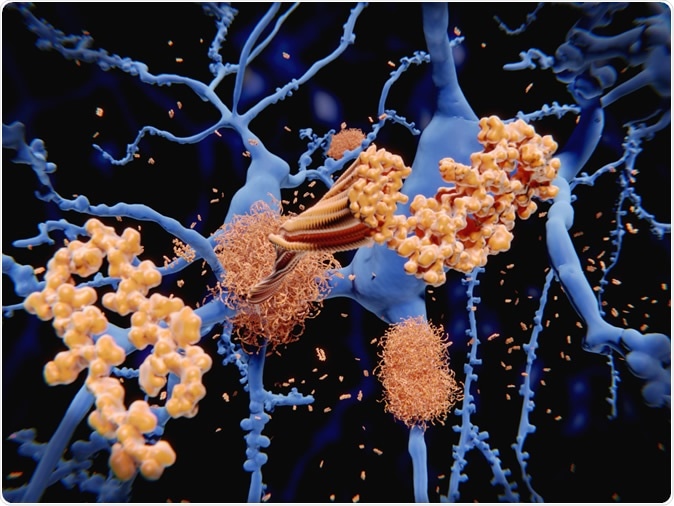In an astonishing new breakthrough in Alzheimer’s research, the molecular basis of early-onset Alzheimer’s disease (AD) and age-linked AD has been identified by looking at one type of genetic mutation. This could help to find new ways to treat the underlying abnormality that causes AD, a major killer in the developed world, besides robbing millions of their memory.
Dementia is a neurologic syndrome which causes the failure of several related skills called cognition. This includes memory, thinking, behavior and the ability to carry out the activities of daily living (ADL). The most common form of this dreaded disorder is AD, found in up to 70% of cases. While this has been a major focus of funded research for decades, it continues to plague high and low alike. It is found most often after the age of 65 years. Early-onset AD occurs below the age of 40, and up to 15% of these cases have a genetic tendency.

Alzheimer's disease: the amyloid-beta peptide accumulates to amyloid fibrils that build up dense amyloid plaques. Image Credit: Juan Gaertner / Shutterstock
The pathological hallmark of AD is the beta-amyloid plaque that accumulates in the cell membranes, spanning the width completely. Only about 40 amino acids long, these are formed of fragmented amyloid precursor protein (APP) which is cut into smaller pieces by various enzymes. The beta-amyloid is formed by the action of several enzymes like β- and γ-secretase. The latter enzyme produces the beta-amyloid peptides which become dangerous in larger amounts. The former produces fragments of different lengths, some pathogenic and others not so much, at 42 and 40 residues in length. About 9 times as much of the 40-peptide type is found in humans as the 40-peptide length type. When this ratio goes up, it shows too much 42-peptide form is being synthesized.
Many causes are being investigated for this disorder, including the possible activation role of beta-amyloid in innate immunity, leading to excessive inflammation and other brain injuries. The current research looked at the so-called Australian mutation that causes Australian early-onset type disease. This autosomal dominant mutation is found in a part of the molecule called the TM domain. They compared the structure of this domain in the mutant protein with that found in the wild-type or normal protein, using nuclear magnetic resonance (NMR) and computer simulations.
High-resolution NMR showed that a mutation called L723P caused the last turn of the helix in the APP TM domain to unfold. In addition, the part of the domain that is located at the center of the cell membrane is straighter and more stable than in the normal form. Another change is in the increased opening of the domain to water molecules, which means that the γ-secretase is now able to act at a slightly different site. This simple set of changes shifts the whole frame of cleavage, producing alternating pathogenic and nonpathogenic peptides. The result is an overall increase in the amount of pathogenic peptide, and an increased Aβ42/Aβ40 ratio.
The study is remarkable because it shows a simple mechanism that is capable of producing the disease through a very direct route, just by causing a structural alteration of the key protein beta-amyloid by a single mutation. The effects are devastating, leading to abnormal enzymatic action and the buildup of the pathogenic 42-peptide around the neurons, leading to damage and death of brain cells.
Instead of the “Australian” mutation, similar effects could well be produced by other similar mechanisms, like local oxidative stress caused by reactive oxygen or nitrogenous species on the peptide. Similarly, a change in the composition of the membrane fat molecules could trigger such a change. This could be the effect of as simple a factor as increased cholesterol levels in the body. Thus the higher frequency of AD with age may be easily explained by these simple mechanisms. Understanding what happens at the molecular level to generate abnormal protein fragments that cause amyloid to accumulate is a vital part of developing newer and better treatment strategies to arrest the disease process at the beginning.
Researcher Eduard Bocharov says, “We described a cascade of events happening within and around the cell membrane as APP is cut by γ-secretase enzyme complex. We have thus used a single “Australian” mutation to reveal molecular mechanisms behind the pathogenesis that may lead both to early onset of Alzheimer’s and the age-related form of the disease.”
The study was published in the journal ACS Chemical Biology on June 10, 2019.
Source:
Journal reference:
Familial L723P mutation can shift the distribution between the alternative app transmembrane domain cleavage cascades by local unfolding of the ε-cleavage site suggesting a straightforward mechanism of Alzheimer’s disease pathogenesis. Eduard V. Bocharov, Kirill D. Nadezhdin, Anatoly S. Urban, Pavel E. Volynsky, Konstantin V. Pavlov, Roman G. Efremov, Alexander S. Arseniev, & Olga V. Bocharova, ACS Chemical Biology 20191471573-1582. June 10, 2019. https://doi.org/10.1021/acschembio.9b00309. https://pubs.acs.org/doi/full/10.1021/acschembio.9b00309